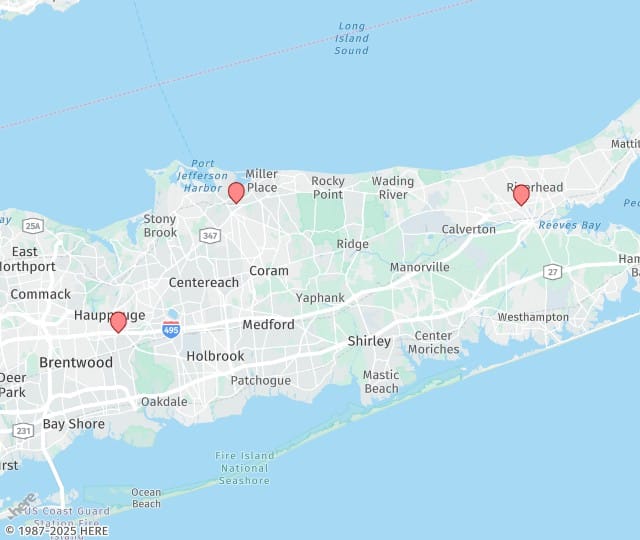At Suffolk Vascular & Vein Center, our team is devoted to offering the utmost care to each patient. From our three convenient locations, we provide a variety of treatments that can help resolve the many symptoms of vein diseases. We welcome you to contact an office near you in Hauppauge, Port Jefferson Station, or Riverhead, NY to schedule a consultation with a vein specialist.
What Are the Symptoms of a Vein Disorder?
The symptoms of vein disorders may differ depending on the condition you have developed. One of the most common symptoms is having visible veins on the ankles, legs, or other areas. Sometimes, symptoms may be more subtle than seeing a discolored, squiggly vein or a twisted, protruding vein.
If you have varicose veins, you may experience symptoms such as:
Symptoms may worsen as the day goes on due to the pressure within the dysfunctional veins. Varicose veins are the most common symptom of a broader condition called chronic venous insufficiency. Other symptoms of this condition include spider veins, leathery or shiny skin, flaking skin, and tiny blood vessels that burst. The skin near the ankles may look reddish-brown. If CVI is not treated, there is a risk of developing ulcers.
If you currently have varicose veins, you also have a significantly higher risk of developing deep vein thrombosis. It is important to be familiar with the signs and symptoms of this condition because DVT can be very serious if not handled properly. Deep vein thrombosis is a blood clot in a deep vein. If the clot dislodges, it can travel to the lungs or heart, where it can have catastrophic effects. According to research, only about half of the people who develop a DVT also have symptoms. These may include a sense of pressure in the legs, pain, swelling, redness, tenderness, and skin warmth.
What’s the Difference Between Varicose and Spider Veins?
Varicose veins and spider veins are similar in that they are both caused by the weakening of blood vessel valves and walls. The difference is their size and location. Spider veins are the tiny capillaries that are situated near the skin. When the valves in these blood vessels stop working efficiently and blood pools, you see small “webs” of purple, blue, and red. Spider veins can swell but this is usually subtle because the veins are so small. Varicose veins occur in blood vessels that are larger and slightly deeper beneath the skin. You might see some bluing or other discoloration of the vein but, primarily, varicose veins look swollen and twisted as they protrude outward. Varicose veins can also become symptomatic and painful, whereas spider veins typically do not cause many symptoms beyond their appearance.
Why do Vein Diseases Occur More in the Legs?
We normally see varicose veins and spider veins in the calves and thighs. Hidden varicose veins can also occur in the pelvic area. The reason is simple. Blood has to travel the farthest away from the heart to reach the feet. On its return to the heart, blood must flow upward against gravity. As a consequence, the veins in the legs tend to experience more pressure than veins elsewhere in the body. Under circumstances that increase pressure or weaken the veins, chronic insufficiency can develop.
What Treatment is Best for Me?
Our team of vein and vascular specialists has mastered the performance of a variety of vein treatments. Each has been proven safe and effective in clinical trials. The treatment that you ultimately choose will be one that your provider is confident can eliminate the problem, and one that you prefer for its technique or other factors. We offer sclerotherapy, a form of injectable therapy, laser and radiofrequency ablation, and ambulatory phlebectomy for the efficient treatment of spider veins and varicose veins. During your consultation, you have the opportunity to explore the options that are appropriate for your situation and also to ask all of the questions you have about each.
Can Vein Diseases be Cured?
Chronic venous insufficiency and the varicose veins and spider veins that it causes may not be curable with vein treatment alone. You may have hereditary factors that put you at risk for the development of new varicose or spider veins. What your vein specialist focuses on in your treatment plan is the elimination of distended, unsightly, uncomfortable veins. The underlying cause of venous insufficiency may be addressed to some extent with your lifestyle choices. After undergoing vein treatment, your doctor may discuss ways that you can reduce your risk of new veins developing. Examples include wearing compression stockings while working or exercising, elevating your legs at the end of the day, and maintaining a healthy weight.
Who is at Risk for Vein Disease?
More than half of all adults develop venous insufficiency at some point in their lives. Vein disease primarily occurs in women, perhaps due to the frequency of hormonal changes that occur. The veins may also lose their efficiency as a result of injury to the leg or legs. For example, any person whose legs have repetitively been used to kick or block, such as in martial arts practice, may have a higher risk of developing varicose veins and also DVT. If you have a family history of vein disease, your risk is elevated. There is also a greater chance of developing chronic venous insufficiency if you smoke, are relatively inactive, or are overweight. These lifestyle factors increase the pressure on the veins, promoting weakness and distention.
